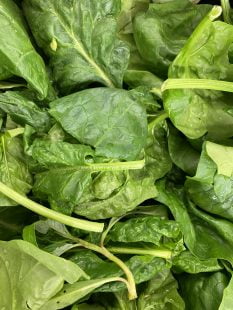Savoirs
Spinach for rabbits

Spinach for Rabbits
It may not make him as strong as Popeye (well, maybe…), but spinach will provide a ton of other benefits to your rabbit just by being added to his menu. In what quantity, how often can you give him some… I tell you everything in this article 👇
In practice
This pretty green leaf is rich in provitamin A, as well as vitamin C, B9 and K1. As for minerals and trace elements, spinach contains large amounts of manganese and… calcium.
It is this high calcium content, combined with a high level of oxalates, that should encourage us to limit the consumption of spinach in our rabbits’ diet: only a few leaves, no more than one day out of two, and only if your rabbit does not already suffer from kidney issues such as sand-like pee or stones – in which case, this food should be excluded from its diet.
Stems and leaves are edible, as long as they are green.
- Epinard pour le lapin
Origin of the Spinach
Originating in the Middle East, spinach was first cultivated in Bactria (present-day Afghanistan and Tajikistan) before reaching Persia in the sixth century AD.
It was not until the 12th or 13th century A.D. (the sources are discordant on this subject) that this leafy vegetable arrived in Europe. Was it thanks to the Crusaders who brought it back from Jerusalem, or thanks to the Arab conquest in Spain? This is still a mystery 🤷♀️ Still, its name, spinach, comes from the Arabic isbinakh, itself from the Persian aspanaakh.
At the time, it only had a moderate success. The Europeans prefered its cousins orach and New Zealand spinach. However, it grows earlier than them, allowing it to be consumed at the time of Lent, which is why it earned the name of “Lenten herb”, and thus slowly settled in the cultures of the time.
Its meager success was shortened, however, by the famous Catherine de Medici (who lived in XVI century). She popularized it in cooking, especially in dishes called “Florentine” (in other words, a dish based on spinach steamed in butter and Mornay sauce).
Gardening/where to get spinach for rabbits
There are two types of spinach: those sown in the cold season (late winter/early spring) and harvested in the warm days of spring and summer; and those sown in the summer and harvested in the winter. This explains why spinach can be found in almost any season 🙃
The difficulty of growing spinach is due to the fact that it goes to seed quickly in hot, dry weather. Also, if you want to grow it easily, choose the second variety, the one to be planted in summer and harvested in winter (less germination problems thanks to a warmed soil, and almost no risk of going to seed! 💪).
You can grow it in your garden, but also in a pot or a window box if you live in an apartment. Be careful though, for the reasons mentioned above, it is not advisable to grow it indoors, unless you let your rabbit munch on the tender young leaves well before the plant matures 😉
Preserving spinach for rabbits
Spinach leaves are unfortunately fragile and can only be stored for a short time in the refrigerator (4-5 days maximum, for ultra-fresh spinach).
To best preserve them, take a resealable bag and a slightly dampened paper towel. Rinse your spinach leaves, let them dry, then put them in the paper towel, then in the bag. Close the bag and place it in the crisper of your refrigerator. Be careful though, at the slightest sign of yellowing, don’t feed it to your rabbit anymore, since the oxidation process will have released a toxic compound in the leaves!
Recipe for Humans
How about traveling a bit with a recipe straight from Greece? 🏖
Servings 4:
- 500g spinach leaves
- 200g feta cheese (or vegan equivalent)
- 2 onions
- 10 filo
- 1 tablespoon flour
- 2 eggs (or 120g silken tofu)
- Olive oil
Preheat your oven to 180°C.
Coarsely chop the spinach and onions, then fry them in a pan in a little olive oil for about 5 minutes: the spinach should have “melted”. Remove from the heat and transfer the mixture to a bowl.
Add the crumbled feta cheese (or vegan cheese) and mix. Add the eggs (or crushed silken tofu) and flour. Mix and set aside.
Take a sheet of filo pastry, cover it with olive oil and fold it lengthwise in three.
Spread some spinach mixture (about a tablespoon), then fold your dough into a triangle (like samosas). Put the final excess into the slit of the previous folding to seal it all together, then bake for 20 minutes. And that’s it! Now all you have to do is give your rabbit a few raw leaves that you reserved on purpose, and both of you can enjoy your meal ! 🙂

 Food
Food Essentials
Essentials Toys
Toys Accessories
Accessories Goodies
Goodies


